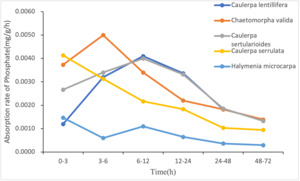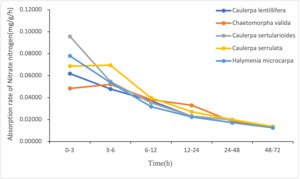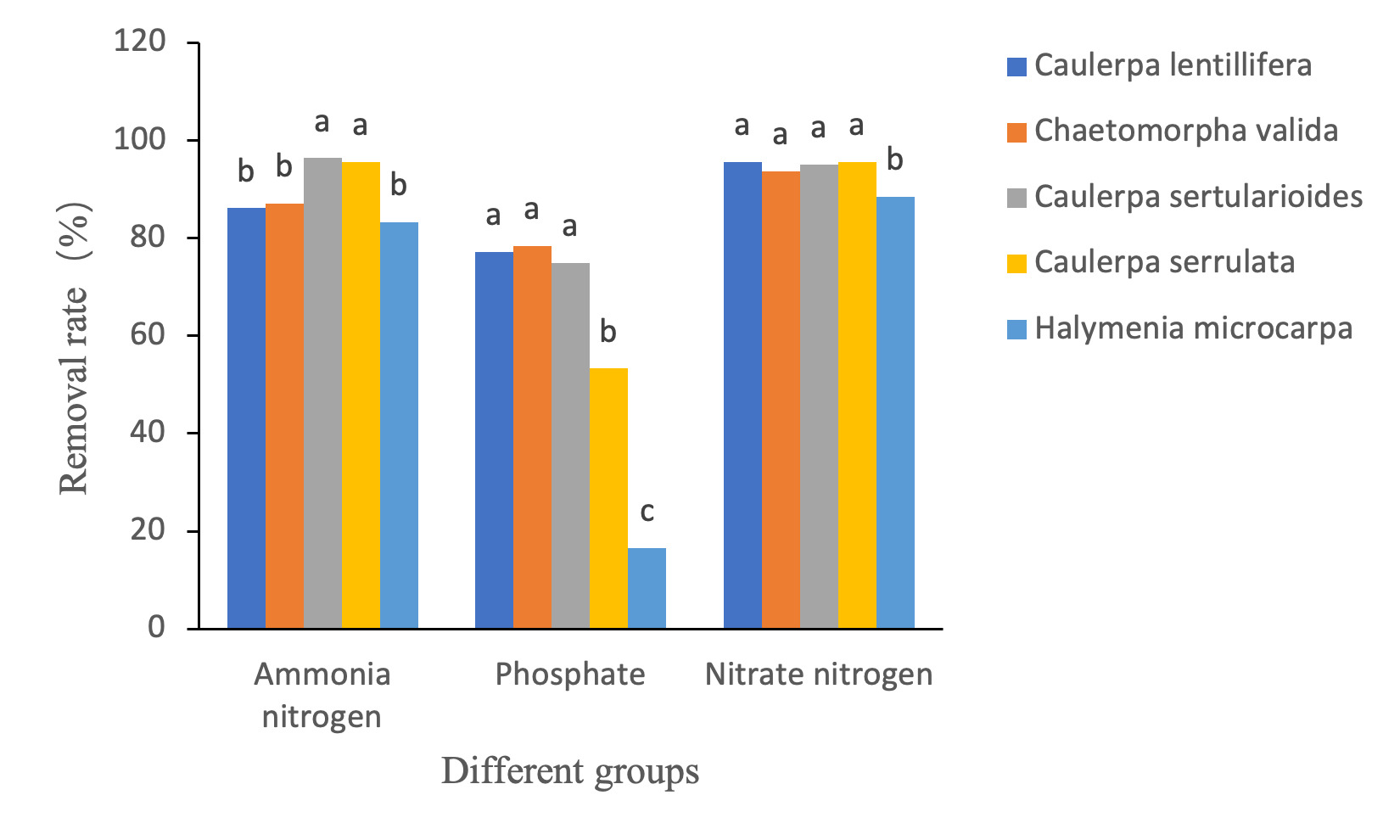Introduction
The aquaculture industry has expanded rapidly in recent times. Although aquaculture has made great strides, the ecology and the environment as a whole have suffered greatly as a result. Aquaculture produces a lot of tailwater because of its high density and intense feeding. Unutilized feed and aquatic product metabolites result in a large amount of nutrients such as nitrogen, phosphorus, and oxygen consuming organic matter in the aquaculture tailwater. Water becomes eutrophic when tailwater from aquaculture is dumped into natural water bodies. An essential step in ensuring the sustainable growth of aquaculture is the efficient control and management of the nutrient-rich tailwater.
At present, the methods for treating aquaculture tailwater and eutrophic seawater are mainly physical, chemical and biological treatment. Using macroalgae to treat aquaculture tailwater and repair eutrophic waters is one of the main topics for future research. By utilizing inorganic carbon for photosynthesis and absorbing large amounts of nitrogen and phosphorus from the surrounding environment, macroalgae could effectively purify aquaculture tailwater. Furthermore, macroalgae is an important aquatic product that provides biological resources for the synthesis of alginate or fertilizer.1–3 Certain financial advantages could be attained when macroalgae was employed to cure aquaculture tailwater, accomplishing two goals at once. Eutrophic saltwater was restored by using Porphyra yezoensis Ueda.4,5 The aquaculture tailwater was improved by using Ulva pertusa.6,7 Gracilaria lemaneiformis and Sebastodes fuscescens were co-cultured to reduce the quantity of nitrogen in the water body produced by ammonia.8 A hybrid shellfish and algae cultivation system was created to remediate eutrophic water.9,10 Previous research has shown that macroalgae remediation or improvement of aquaculture water bodies had significant effects.
In ecological aquaculture systems, macroalgae act as a biological filter that absorbs nitrogen and phosphorus nutrients. However, the effectiveness of this biological filter depends on the initial concentration of nitrogen and phosphorus in macroalgae species and tailwater, as well as the form in which these nutrients are already present. The ability to identify high-performing macroalgae species for aquaculture tailwater purification and increase the effectiveness of tailwater treatment depends on the evaluation of the nitrogen and phosphorus absorption properties of various macroalgae species in aquaculture tailwater. At present, there is insufficient understanding of the ability of various macroalgae to remove nitrogen and phosphorus nutrients, which has led to limitations in the selection of macroalgae species for improving water quality. In order to further the research in this field and serve as a guide for the use of macroalgae for tailwater treatment, this experiment gathered five different types of macroalgae, including Caulerpa lentillifera, Caulerpa sertularioides, Caulerpa serrulata, Halymenia microcarpa and Chaetomorpha valida, and compared their effects on nutrient absorption.
Materials and Methods
Materials
Experimental materials
Caulerpa lentillifera, Caulerpa sertularioides, Caulerpa serrulata, Halymenia microcarpa and Chaetomorpha valida were collected from the South China Sea Fisheries Research Institute’s Shenzhen Test Base, according to the Chinese Academy of Fisheries Sciences. The healthy macroalgae were selected and pre-cultured in 10L seawater with the same experimental environment for one week. Natural seawater that had been treated with sand filtering, dark precipitation, and UV sterilization for two weeks made up the pre-cultured seawater. Salinity was 30± 1 ppt, the seawater’s pH was 8.0± 0.2, the temperature was 26 ±1°C, the light intensity ranged from 4000 to 6000 lux, the light cycle was 12:12 light:dark, and air was constantly inflated for 24 hours. For the macroalgae to receive light uniformly, stired the macroalgae three times a day.
Cultivation water body
The culture water were prepared by weighing an appropriate amount of NH4Cl and KH2PO4 and adding them to seawater that had been disinfected for 24 hours by sand filtration ultraviolet light. The ammonia nitrogen concentration was 0.6 ±0.05 mg/L and the phosphate concentration was 0.3± 0.05 mg/L.
Methods
Removal of nitrogen and phosphorus by macroalgae
Ten grams of each macroalgae were weighed before being added to the culture container with test water. The water container used in the experiment had a 4 L capacity. The experiment called for three parallel samples. A 72-hour incubation period was included. Three replicates were made for each group, and samples were collected at 0, 2, 4, 6, 12, 24, 48 and 72 hours, respectively. 50 ml of water samples were taken for each time period and measured 3 times.
Determination method
The GB17378.4-2007 was used as a standard for water quality analysis methods. The active phosphorus was determined by using the ascorbic acid reduction-molybdenum blue method, the cadmium column reduction method was used to determine nitrate nitrogen, and the sodium hypobromate oxidation method was used to determine ammonia nitrogen, then used the following calculation to determine the final algae absorption rate for each time period:
U=(Ct1−Ct2−C0)·V/(t·G)
In the formula, U was the absorption rate, Ct1 was the average nitrogen and phosphorus content of the three culture groups measured at the beginning of the experiment, Ct2 was the average nitrogen and phosphorus content of the three experimental groups measured at the end of the experiment, C0 was the change of ammonia and nitrogen content of the control group, V was the volume of the culture solution used, t was the culture time, and G was the biomass of algae added.
Data processing and analysis
The data were shown as the mean and standard deviation (Mean±S.D). For the statistical analysis of the data, SPSS software was employed. Duncan’s multiple method of One way ANOVA was used to compare the differences between the treated seaweed data, with P<0.05 as the significant level of difference.
Results
Removal of ammonia nitrogen
The experiment’s findings demonstrated that the five macroalgae’s ammonia nitrogen concentrations in the test water body declined with time, with a significant difference between the 72-hour concentration and the beginning concentration. Table 1 demonstrated that Caulerpa sertularioides and Caulerpa serrulata were the most effective at removing ammonia nitrogen from the water body. The absorption efficiency was 96.4% and 95.5%, respectively (Fig. 1), and the concentration of ammonia nitrogen in the cultured water body decreased from 0.605 mg/L to 0.022 mg/L and 0.027 mg/L, respectively, within 72 hours. The absorption efficiency was 87.1%, 86.1%, and 83.3%, respectively (Fig. 1), as the concentration of ammonia nitrogen in the water body of Chaetomorpha valida, Caulerpa lentillifera and Halymenia microcarpa culture reduced from 0.605 mg/L to 0.078 mg/L, 0.084 mg/L, and 0.101 mg/L, respectively. As a result, the five types of macroalgae were ranked according to their ability to remove ammonia nitrogen as follows: Caulerpa sertularioides, Caulerpa serrulata, Chaetomorpha valida, Caulerpa lentillifera and Halymenia microcarpa.
According to Figure 2, the absorption rate of Caulerpa sertularioides was slightly lower than that of Chaetomorpha valida in 3-6 hours, and consistently larger than that of the other four types of macroalgae during other periods, but the difference gradually shrinks as the length of the culture increases. The absorption rates of Chaetomorpha valida and Caulerpa serrulata in 0–3 hours were higher than Caulerpa sertularioides and lower than those of Caulerpa lentillifera and Halymenia microcarpa. Chaetomorpha valida’s absorption rate quickly escalated to its maximum within 3–12 hours before gradually declining. The absorption rate of Caulerpa serrulata gradually increased to its maximum within 3-12 hours, then rapidly decreased. The absorption rates of Caulerpa lentillifera and Halymenia microcarpa were relatively low in the first 0–6 hours, rapidly increased to their maximum in the following 6–12 hours, then gradually decreased, and the change of absorption rate tended to be mild in the following 48–72 hours. The average absorption rates of the Caulerpa sertularioides, Caulerpa serrulata, Chaetomorpha valida, Caulerpa lentillifera and Halymenia microcarpa in the 72-hour culture cycle were 0.0032, 0.0032, 0.0029, 0.0029 and 0.0028 mg/g·h, respectively.
Removal of active phosphorus
According to the experimental findings, there was a significant difference between the 72-hour concentration and the beginning concentration, and the phosphate concentration of the five macroalgae in the experimental water body decreased with time. Chaetomorpha valida, Caulerpa lentillifera and Caulerpa sertularioides had relatively strong removal capacities of active phosphorus in water bodies, which was significantly higher than Caulerpa serrulata and Halymenia microcarpa. Halymenia microcarpa had the worst capacity to remove active phosphorus in water, as can be seen in Table 1. The concentration of active phosphorus in the culture water of Chaetomorpha valida, Caulerpa lentillifera and Caulerpa sertularioides decreased from 0.319 mg/L to 0.069 mg/L, 0.073 mg/L, and 0.08 mg/L, respectively, at 72 hours of the experiment, and the absorption efficiency were 78.4%, 77.1%, and 74.9%, respectively (Fig. 1). The concentration of active phosphorus in the culture water of Caulerpa serrulata and Halymenia microcarpa decreased from 0.319 mg/L to 0.149 mg/L and 0.266 mg/L, respectively, and the absorption efficiency were 53.3% and 16.6%, respectively (Fig. 1). As a result, Chaetomorpha valida was more effective in removing contaminants than Caulerpa lentillifera, Caulerpa sertularioides, Caulerpa serrulata and Halymenia microcarpa.
As shown in Figure 3, Chaetomorpha valida and Caulerpa serrulata absorbed more phosphate in the first three hours than the other three types of macroalgae. The absorption rate of Chaetomorpha valida rapidly increased to the maximum in 3-6 h, and then rapidly decreased to a gentle level, while Caulerpa serrulata slowly decreased in 3-72 h. The absorption rate of Caulerpa sertularioides gradually increased to the maximum within 0-12h, and then decreased rapidly. The absorption rates of Caulerpa lentillifera and Halymenia microcarpa were the lowest within 0-3 hours, and the absorption rate of Caulerpa lentillifera rapidly increased to the maximum within 3-12 hours, the absorption rate of Halymenia microcarpa was relatively flat. During the 72-hour culture cycle, the average absorption rates of Chaetomorpha valida, Caulerpa lentillifera, Caulerpa sertularioides, Caulerpa serrulata and Halymenia microcarpa were 0.0014, 0.0014, 0.0013, 0.0009 and 0.0003 mg/g·h, respectively.
Removal of nitrate nitrogen
The findings of the experiment demonstrated that the five macroalgae’s nitrate nitrogen concentration in the test water body reduced with time, with a significant difference between the 72-hour concentration and the beginning concentration. Table 1 demonstrates the relative strength of the ability of Caulerpa lentillifera, Caulerpa serrulata, Caulerpa sertularioides and Chaetomorpha valida to extract nitrate nitrogen from water bodies. Within 72 hours, the nitrate nitrogen concentration in the cultured water body decreased from 2.567 mg/L to 0.115 mg/L, 0.115 mg/L, 0.127 mg/L, and 0.163 mg/L, respectively, with absorption efficiencies of 95.5%, 95.5%, 95.1% and 93.7%, respectively (Fig. 1). The nitrate nitrogen concentration in the culture water of Halymenia microcarpa decreased from 2.567 mg/L to 0.297 mg/L, with an absorption efficiency of 88.4%. Therefore, the removal capacity of the five macroalgae were in the following order: Caulerpa lentillifera and Caulerpa serrulata, Caulerpa sertularioides, Chaetomorpha valida and Halymenia microcarpa.
As shown in Figure 4, the absorption rate of Caulerpa sertularioides was significantly higher than that of the other four kinds of macroalgae in 0-3 hours, and the trend decreased rapidly at first and then tended to be flat. The absorption rates of Chaetomorpha valida and Caulerpa serrulata increased slowly in the period of 0-6h, and then decreased rapidly to flat. The absorption rates of Caulerpa lentillifera and Halymenia microcarpa decreased slowly to a flat level in the period of 0-72 h. The average absorption rates of Caulerpa lentillifera, Caulerpa serrulata, Caulerpa sertularioides, Chaetomorpha valida and Halymenia microcarpa were 0.01362, 0.01362, 0.01356, 0.01336, and 0.01261 mg/g·h, respectively, during the 72 h culture cycle.
Discussion
The research on removing nitrogen and phosphorus nutrients by macroalgae mainly focused on several common macroalgae, such as gracilaria and ulva lactuca. The experimental environment was mainly an open mixed culture mode, such as fish algae or shrimp algae. These experimental results were different, but they all found that macroalgae can significantly reduce the nutrient content in the aquaculture system and improve the quality of aquaculture water.11–14 The results of this study also proved that the Caulerpa sertularioides, Caulerpa serrulata, Chaetomorpha valida, Caulerpa lentillifera and Halymenia microcarpa had a good removal effect on nitrogen and phosphorus nutrients in seawater, especially the Caulerpa sertularioides. The study found that among the five kinds of macroalgae, the Caulerpa sertularioides had a strong ability to remove nitrogen and phosphorus nutrients, the Caulerpa serrulata had a strong ability to remove nitrogen, and the Chaetomorpha valida had the strongest ability to remove phosphorus. This could be connected to the morphology of Caulerpa sertularioides, which possessed a feather-like body form and a greater surface area in contact with seawater, which facilitated the absorption of nutrients.
According to Hockin et al.,15 macroalgae have the ability to absorb, consume, and eliminate nitrogen in various forms. The nitrogen nitrate that was ingested can be transformed into ammonia nitrogen for absorption via reductase activity. The findings indicated that the nitrate nitrogen was easily absorbed by Pteridophyta elongata.16,17 He et al.18 found that ammonia nitrogen was easily absorbed by Ulva pertusa, Enteromorpha clathrata, and Chondrus niponicus. These results showed that the absorption rate of ammonia nitrogen by five types of macroalgae first increased and then decreased, which might be due to the rapid and large absorption of nitrogen by macroalgae after brief adaptation and preparation when transferring from a low nitrogen environment to a high nitrogen environment. Compared to Caulerpa lentillifera and Halymenia microcarpa, Caulerpa sertularioides, Caulerpa serrulata and Chaetomorpha valida were more suitable for removing ammonia nitrogen. The absorption rate of nitrate nitrogen by five types of macroalgae showed a slow decreasing trend, and the difference in absorption rate was not significant. Caulerpa sertularioides was more suitable for removing high nitrate nitrogen. It was feasible to selectively cultivate macroalgae to get rid of a particular type of high concentration nitrogen source by researching how five different varieties of macroalgae absorbed different nitrogen sources.
In conclusion, a lab setting that mimicked the nitrogen- and phosphate-rich saltwater of the five species of macroalgae was selected for this experiment, Caulerpa lentillifera, Caulerpa sertularioides, Caulerpa serrulata, Hymenolepis microcarpa and Chaetomorpha valida were utilized to study the macroalgae. The results showed that macroalgae were very successful in removing nutrients, with Caulerpa sertularioides having a significantly greater removal effect than the other four macroalgae species. This provides a standard for improving the marine environment. However, the experimental conditions limited the species and length of cultivation of the macroalgae that were studied. To filter out macroalgae that are better adapted to different water quality conditions, more research and comparison are necessary.
Acknowledgments
This work was supported by the Shenzhen Dapeng New Area Science and Technology Innovation and Industrial Development Special Fund Support Project (202001-27); Shenzhen Industrial Development Special Fund Project (1303); National Natural Science Foundation (31902423); Hainan Provincial Natural Science Foundation (323QN329) ;Special financial project of the Ministry of Agriculture and Rural Affairs, sub-project: Algae Living Germplasm Bank (NFZX2018); Collection, storage and shared utilization of large algae (NHYYSWZZZZYKZX2020).
Author’s contributions per CRediT
Writing – original draft: Wenwen Zhang (Lead). Writing – review & editing: Wenwen Zhang (Lead). Formal Analysis: Yan Ni (Equal), Ting Li (Equal). Investigation: Yan Ni (Equal), Ting Li (Equal). Supervision: Jiangyong Wang (Lead). Resources: Wenchuan Zhou (Equal), Tao Li (Equal). Conceptualization: Suwen Chen (Lead). Methodology: Suwen Chen (Lead). Funding acquisition: Tao Li (Lead).








